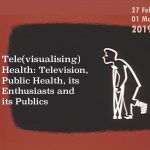 ERC BodyCapital, Département d’Histoire des Sciences de la Vie et de la Santé; Center for History in Public Health, London School of Health and Tropical Medecine (LSHTM) (Web)
ERC BodyCapital, Département d’Histoire des Sciences de la Vie et de la Santé; Center for History in Public Health, London School of Health and Tropical Medecine (LSHTM) (Web)
Venue: Dickens Library, Mary Ward House, London
Time: 27.02.-01.03.2019
Televisions began to appear in the homes of large numbers of the public in Europe and North America after World War II. This coincided with a period in which ideas about the public’s health, the problems that it faced and the solutions that could be offered, were changing. The threat posed by infectious diseases was receding, to be replaced by chronic conditions linked to lifestyle and individual behaviour.
Public health professionals were enthusiastic about how this new technology and mass advertising could reach out to individuals in the population with the new message about lifestyle and risk. TV offered a way to reach large numbers of people with public health messages; it symbolised the post war optimism about new directions in public health.
But it could also act as a contributory factor to those new public health problems. Watching TV was part of a shift towards more sedentary lifestyles, and also a vehicle through which products that were damaging to health, such as alcohol, cigarettes and unhealthy food, could be advertised to the public. Population health problems could be worsened by TV viewing. Read more … (Web)
Salon 21
Ankündigungsweblog für Frauen- und Geschlechtergeschichte
